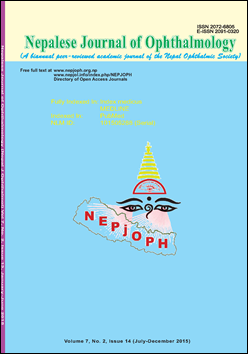Diabetic retinopathy with or without clinically significant macular edema: The influencing factors
DOI:
https://doi.org/10.3126/nepjoph.v7i2.14964Keywords:
Diabetic retinopathy, Clinically Significant Macular Edema, Influencing factorsAbstract
Introduction: Diabetic retinopathy is the commonest micro vascular complication in patients with diabetes and remains a leading cause of blindness in people of working age group.
Objective: to determine the prevalence of clinically significant macular edema (CSME) and the influence of systemic risk factors
Materials and methods: It is a hospital based comparative study conducted in 220 eyes of 110 diabetic patients. DR was graded according to International Clinical Diabetic Retinopathy Severity Scale and CSME was defined according to Early Treatment Diabetic Retinopathy Study (ETDRS) system. The patients were grouped as 1) CSME group (DR and CSME in one or both eyes) and 2) Non- CSME group(CSME in none of the eyes but with any grade of DR).Level of glycosylated hemoglobin (HbA1C), serum total cholesterol, triglyceride (TG), low density lipoprotein (LDL), high density lipoprotein (HDL) and urine for albumin were studied in both groups.
Results: CSME was present in 36% of 110 patients. Poor glycemic control and high total cholesterol level showed positive association with CSME (p<0.05). LDL and TG levels were higher and HDL lower in CSME group. However, no statistical significance was found.
Conclusion: The CSME is significantly associated with poorer glycemic control and elevated total cholesterol level.
Downloads
Downloads
Published
How to Cite
Issue
Section
License
This license enables reusers to copy and distribute the material in any medium or format in unadapted form only, for noncommercial purposes only, and only so long as attribution is given to the creator.




